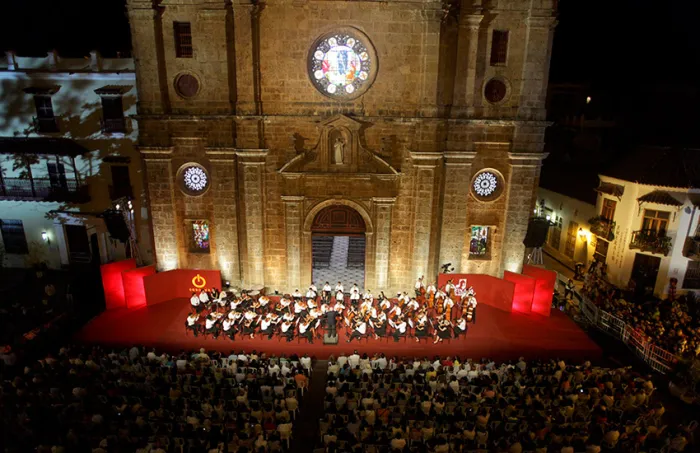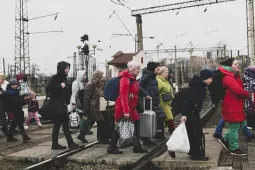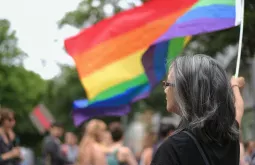Baroque music inside and beyond the wall

It’s after 10 pm, and in the main square of the Getsemani neighborhood, in front of the Trinidad Church the excitement is at its height: local group is playing champete, the typical Carribean popular music of Colombian Cartagena. The best dancers are in a spontaneous group of three and four-year old black kids, but no one in the crowd can listen without moving to the music. Plastic glasses filled with rum are in the hands of the adults, street vendors push their carts packed with cigarettes and candy towards every corner of the square in the once poor but now slowly developing part of the city.
Three days before at the same hour Plaza de la Trinidad showed a different image. Elegant people filled the rows of seats in front of the stage. Cameras, microphones prepared for a television recording, but the majority of the people remained outside, squeezed to the narrow pavement around the steel barriers. They were those who arrived late to the offices giving a limited number of free tickets, or those who never even had the chance to get there. And there were those who were not interested: on the street that leads to the square an old man watched TV outside on his stoop, and some friends decided to call the whole street to party to their home. And while 100 meters away some of Latin America’s best musicians were playing, salsa was blaring around a handmade board saying “Viva el Caribe”. All who passed by stopped to dance.
But those who were around and listened to the concert presenting an overview of Latin America’s new music, could hear a promising fresh voice from the Argentine pianist, Diego Schissi, influenced deeply by the music of Astor Piazzolla. They could also hear the samba version of Beethoven’s Fifth Symphony by the soft-voiced Brazilian singer, Mónica Salmaso, and her fellow pianist, whose playing would easily be considered an individual piece while giving an accompaniment at the same time, and could hear the 17 year old prodigy, cellist Santiago Cañón.
A year ago organizers faced more difficulties at the Cartagena International Music Festival when wanted to extend the program to the Getsemani area. In this classical music event, founded in 2005, the concerts took place within the historic city surrounded by a 10 km long wall. The majority of the owners of the houses there are foreigners or rich people from Bogota. Locals moved further in the city and the 500 year old houses became boutique hostels and restaurants for tourists.
The Getsemani district near the center was the first outside the wall, where the organizers planned to have an outdoor concert that became a scene of local resistance. People were not keen on having an event on their main square, the part of their everyday life. The conflict calmed down when the two sides found a common interest. „I learned that people in Getsemani were afraid of losing their square, the income of the vendors, the shops, the restaurants for the time of the festival. They considered us invaders. Finally we agreed that while we worked there, we filled the restaurants, gave space to the street vendors and spent money in the local shops” – says Julia Salvi, director of the foundation that organizes the festival. It was the first time that classical music resounded besides the Carribean rhythms in Getsemani.
In the historic center, in the inner court of the Hotel Santa Teresa, where colonial style furniture is accompanied by an impressive amount of tropical plants, Julia Salvi explains their story with a vivid look. With her Italian husband, Victor Salvi, a harpist and a luthier, they accomplished their dream when they found Cartagena de Indias with the perfect conditions of a festival city and founded their classical music festival opening a new world for Colombians who have such a strong tradition of popular music, or “musica popular”.
"Initially we brought popular classical chamber music. First Mozart, then we dared to bring masses of Bach. Gradually we started to educate people: how to applaud, how to listen to music.”
As she says, the majority of those who learn classical music come from the poor. She wanted to show these children who knew only their teachers as musicians, who sometimes teach other then their own instrument, what it is like when a true master plays music. And to those who chose New York or Miami as a concert destination they wanted to give the opportunity to do the same at home and travel only to the North border of the country”-says Señora Salvi.
The audience not only learned the etiquette of applauding, but also the fact that classical music can be a source of joy besides the rich popular music culture. Today concerts are crowded, even the 170 dollar seats are not empty.
In January of 2013 Italian baroque got the leading role, Vivaldi, Pergolesi and Scarlatti among others filled the colorful buildings of colonial times. Mariamulata birds sometimes add new notes to the pieces in a laughing manner and tropical heat is hard to balance each time in the halls.
The most employed orchestra is the one led by harpsicord player Rinaldo Alessandrini, The Concerto Italiano. The 15 member orchestra plays its country’s baroque masterpieces with authentic instruments from the era.
The recently renovated Teatro Adolfo Mejía is the meeting point of people from the upper class shining in latin elegance and tourists who altogether fill in the 680 seats. Pergolesi’ Stabat Mater is played by the Concerto with the stunning Italian contralto, Sara Mingardo and the Italian soprano, Valentina Varriale. The dramatic performance of the two women strengthens the wonder, how a young composer in his twenties could incorporate such emotions into music. The less known Salve Regina is presented in an unusual way: both singers perform it but in different keys and with different emotional drive.
Mario Brunelli, the innovative cellist besides his almost spiritual performances of baroque music launches a looping machine causing a huge surprise to the audience when he stops playing but his music goes on.
Pergolesi’s operetta, La Serva Padrona which tells a story of a servant who becomes the mistress of her household and marries her gains the devotion of the audience with its lovely performance and an improvised stage setting. The audience passionately jumps up after the concerts applauding with ’bravos’ this way saying thanks for the musical experience, which might be the mixture of latin temperament and the skill of being able to be happy about something new.
In the concert of the Accordon group from Naples, in the huge hall of a once cloister now hotel building people almost bearhug musicians in their euphoria. The orchestra plays tarantella, and some of the 17th century songs from Naples have a carnival flavor and catch the audience immediately.
During the one week of the festival there was Vivaldi’s Four Seasons on show, twice, the impressive Teatro Mejía hosted the Italian violinist, Salvatore Accardo, who besides playing Verdi and Boccherini string quartets conducted the Young Colombians’ Symphonic Orquestra, whose members meet only four times a year to play. French Harpist Xavier de Maistre played Paganini or pieces by Francisco Tárrega the Spanish guitar player and composer, and other Italian and international musicians brought to the people of Cartagena a portion of 400 year’s music.
And all these put into an environment, where people who grew up on Gabriel Garcia Márquez would stop in every corner feeling the proximity of his characters, where crossing the streets from concert to concert one passes Fermina Daza’s house from Love at the Times of Cholera and can imagine Juvenal Urbino trying to catch the parrot from the ladder in a patio like Hotel Santa Clara offers to enjoy waiting for a concert. Where crossing the entrance of the walled historic city the image of Florentino Ariza is appearing writing love letters on behalf of people of Cartagena at the Puerto de Reloj. And appearently more and more in an environment where salsa, champete and cumbia is the usual sound of the streets and squares, like the Plaza de Trinidad, the main square of Getsemani.






